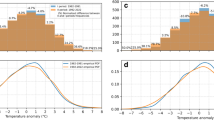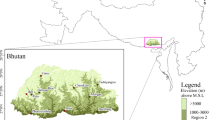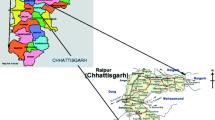Abstract
To understand the variations in vegetation and their correlation with climate factors in the upper catchments of the Yellow River, China, Normalized Difference Vegetation Index (NDVI) time series data from 2000 to 2010 were collected based on the MOD13Q1 product. The coefficient of variation, Theil-Sen median trend analysis and the Mann-Kendall test were combined to investigate the volatility characteristic and trend characteristic of the vegetation. Climate data sets were then used to analyze the correlation between variations in vegetation and climate change. In terms of the temporal variations, the vegetation in this study area improved slightly from 2000 to 2010, although the volatility characteristic was larger in 2000–2005 than in 2006–2010. In terms of the spatial variation, vegetation which is relatively stable and has a significantly increasing trend accounts for the largest part of the study area. Its spatial distribution is highly correlated with altitude, which ranges from about 2000 to 3000 m in this area. Highly fluctuating vegetation and vegetation which showed a significantly decreasing trend were mostly distributed around the reservoirs and in the reaches of the river with hydropower developments. Vegetation with a relatively stable and significantly decreasing trend and vegetation with a highly fluctuating and significantly increasing trend are widely dispersed. With respect to the response of vegetation to climate change, about 20–30% of the vegetation has a significant correlation with climatic factors and the correlations in most areas are positive: regions with precipitation as the key influencing factor account for more than 10% of the area; regions with temperature as the key influencing factor account for less than 10% of the area; and regions with precipitation and temperature as the key influencing factors together account for about 5% of the total area. More than 70% of the vegetation has an insignificant correlation with climatic factors.
Similar content being viewed by others
References
Baret F, Guyot G, 1991. Potentials and limits of vegetation indices for LAI and APAR assessment. Remote Sensing of Environment, 35: 161–173.
Chuai X W, Huang X J, Wang W J et al., 2013. NDVI, temperature and precipitation changes and their relationships with different vegetation types during 1998–2007 in Inner Mongolia, China. International Journal of Climatology, 33: 1696–1706.
Fan N, Xie G D, Zhang C S et al., 2012. Spatial-temporal dynamic changes of vegetation cover in Lancang river basin during 2001–2010. Resource Science, 34: 1222–1231. (in Chinese)
Fensholt R, Langanke T, Rusmussen K et al., 2012. Greenness in semi-arid areas across the globe 1981–2007: An Earth observing satellite based analysis of trends and drivers. Remote Sensing of Environment, 121: 144–158.
Fuller D O, Wang Y, 2014. Recent trends in satellite vegetation index observations indicate decreasing vegetation biomass in the southeastern saline everglades wetlands. Wetlands, 34: 67–77.
Gao Z X, Song Z S, 1984. Hydrographic profiles of the upper catchments of the Yellow River. Journal of China Hydrology, 3: 55–58. (in Chinese)
Gutman G, Ignatov A, 1998. The derivation of the green vegetation fraction from NOAA/AVHRR data for use in numerical weather prediction models. International Journal of Remote Sensing, 19: 1533–1543.
Hao F H, Zhang X, Ouyang W et al., 2012. Vegetation NDVI linked to temperature and precipitation in the upper catchments of the Yellow River. Environmental Modeling and Assessment 17: 389–398.
Hoaglin D C, Mosteller F, Tukey J W, 2000. Understanding Robust and Exploratory Data Analysis. New York: Wiley.
Holben B N, 1986. Characteristics of maximum-value composite images from temporal AVHRR data. International Journal of Remote Sensing, 7: 1471–1434.
Hou X Y, Wu T, Yu L J et al., 2012. Characteristics of multi-temporal scale variation of vegetation coverage in the Circum Bohai Bay Region, 1999–2009. Acta Ecologica Sinica, 32: 297–304.
Jiang W G, Hou P, Zhu X H et al., 2011. Analysis of vegetation response to rainfall with satellite images in Dongting Lake. Journal of Geographical Sciences, 21: 135–149.
Kawabata A, Ichii K, Yamaguchi Y, 2001. Global monitoring of interannual changes in vegetation activities using NDVI and its relationships to temperature and precipitation. International Journal of Remote Sensing, 22: 1377–1392.
Kendall M, 1975. Rank Correlation Methods. London: Charles Griffin.
Li F, Zeng Y, Li X S et al., 2014. Remote sensing based monitoring of interannual variations in vegetation activity in China from 1982 to 2009. Science China Earth Sciences, 57: 1–7.
Li H X, Liu G H, Fu B J, 2011. Response of vegetation to climate change and human activity based on NDVI in the Tree-River Headwaters region. Acta Ecologica Sinica, 31: 5495–5504. (in Chinese)
Li J G, Pu L J, Liu J P et al., 2012. The temporal and spatial characteristics of vegetation activity in Three Gorges Reservoir area (Chongqing) from 2001 to 2010 and its influencing factors. Resources Science, 34: 1500–1507. (in Chinese)
Li S S, Yan J P, Liu X Y et al., 2013. Response of vegetation restoration to climate change and human activities in Shaanxi-Gansu-Ningxia region. Journal of Geographical Sciences, 23: 98–112.
Li W P, Zeng Y, Wu B F et al., 2011. Research and monitoring of vegetation recovery based on remote sensing in the drawdown area of the Three Gorges Bain. Resources and Environment in the Yangtze Basin, 20: 332–338. (in Chinese)
Lu Z J, Li L F, Huang H D et al., 2010. Preliminary effects of impounding on vegetation in drawdown zone of the Three Gorges Reservoir Region. Journal of Wuhan Botanical Research, 28(3): 303–314. (in Chinese)
Lunetta R S, Knight J F, Ediriwickrema J, 2006. Land-cover change detection using multi-temporal MODIS NDVI data. Remote Sensing of Environment, 105: 142–154.
Ma M G, Wang J, Wang X M, 2006. Advances in the inter-annual variability of vegetation and its relation to climate based on remote sensing. Journal of Remote Sensing, 10: 421–431. (in Chinese)
Mao D H, Wang Z M, Song K S et al., 2011. The vegetation NDVI variation and its responses to climate change and LUCC from 1982 to 2006 year in northeast permafrost region. China Environmental Science, 32: 283–292. (in Chinese)
Milich L, Weiss E, 2000. GAC NDVI interannual coefficient of variation (cov) images: Ground truth sampling of the Sahel along north-south transects. International Journal of Remote Sensing, 21: 235–260.
Mu S J, Yang H F, Li J L et al., 2013. Spatio-temporal dynamics of vegetation coverage and its relationship with climate factors in Inner Mongolia, China. Journal of Geographical Sciences, 23: 231–246.
Neeti N, Eastman J R, 2011. A contextual Mann-Kendall approach for the assessment of trend significance in image time series. Transactions in GIS, 15: 599–611.
Nie Q, Xu J H, Cao L et al., 2012. The vegetation coverage dynamic coupling with climatic factors in northeast China transect. Environmental Management, 50: 405–417.
Piao S L, Fang J Y, 2001. Dynamic vegetation cover change over the last 18 years in China. Quaternary Sciences, 21: 194–302. (in Chinese)
Pouliot D, Latifovic R, Olthof I, 2009. Trends in vegetation NDVI from 1 km AVHRR data over Canada for the period 1985–2006. International Journal of Remote Sensing, 30: 149–168.
Quinn C H, Ndangalasi H J, Gerstle J et al., 2005. Effect of the Lower Kihansi Hydropower Project and post-project mitigation measures on wetland vegetation in Kihansi Gorge, Tanzania. Biodiversity and Conservation, 14: 297–308.
Santin-Janin H, Garel M, Chapuis J -L et al., 2009. Assessing the performance of NDVI as a proxy for plant biomass using non-linear models: A case study on the Kerguelen archipelago. Polar Biology, 32: 861–871.
Sen P K. 1968. Estimates of the regression coefficient based on Kendall’s tau. Journal of the American Statistical Association, 63:1379–1389.
Song F Q, Xing K X, Liu Y et al., 2011. Monitoring and assessment of vegetation variation in Northern Shaanxi based on MODIS/NDVI. Acta Ecologica Sinica, 31: 354–363. (in Chinese)
Sun H Y, Wang C J, Niu Z et al., 1988. Analysis of vegetation cover change and the relationship between NDVI and environmental factors by using NOAA time series data. Journal of Remote Sensing, 2: 204–210. (in Chinese)
Theil H, 1950a. A rank-invariant method of linear and polynomial regression analysis: I. Proceedings of Koninklijke Nederlandse Akademie van Wetenschappen, 53: 386–392.
Theil H, 1950b. A rank-invariant method of linear and polynomial regression analysis: II. Proceedings of Koninklijke Nederlandse Akademie van Wetenschappen, 53: 521–525.
Theil H, 1950c. A rank-invariant method of linear and polynomial regression analysis: III. Proceedings of Koninklijke Nederlandse Akademie van Wetenschappen, 53: 1397–1412.
Tosic I, 2004. Spatial and temporal variability of winter and summer precipitation over Serbia and Montenegro. Theoretical and Applied Climatology, 77: 47–56.
Tucker C J, Justice C O, Prince S D, 1986. Monitoring the grasslands of the Sahel 1984–1985. International Journal of Remote Sensing, 7: 1571–1581.
Tucker C J, Newcomb W W, Los S O et al., 1991. Mean and inter-year variation of growing seasons normalized difference vegetation index for the Sahel 1981–1989. International Journal of Remote Sensing, 12: 1133–1135.
Wang F, Wang X, Zhao Y et al., 2013. Temporal variations of NDVI and correlations between NDVI and hydro-climatological variables at Lake Baiyangdian, China. International Journal of Biometeorology, doi: 10.1007/s00484-013-0758-4.
Wu S H, Zhou S L, Chen D X et al., 2014. Determining the contribution of urbanization and climate change to NPP variations over the last decade in the Yangtze River Delta, China. Science of the Total Environment, 472: 397–406.
Wu Z Y, Ren D C, Zhang R Y, 1998. Chronicles of the Yellow River. Zhengzhou: Henan People’s Publishing House, 100–106. (in Chinese)
Xu D Y, Li C L, Zhuang D F et al., 2011. Assessment of the relative role of climate change and human activities in desertification: A review. Journal of Geographical Sciences, 21: 926–936.
Yang Y, Xu J H, Hong Y L et al., 2012. The dynamic of vegetation coverage and its response to climate factors in Inner Mongolia, China. Stochastic Environmental Research and Risk Assessment, 26: 357–373.
Yin F, Deng X Z, Jin Q et al., 2014. The impacts of climate change and human activities on grassland productivity in Qinghai Province, China. Frontiers in Earth Science, 8: 93–103.
Yuan L H, Jiang W G, Shen W M et al., 2013. The spatio-temporal variations of vegetation cover in the Yellow River Basin from 2000 to 2010. Acta Ecologica Sinica, 33: 7798–7806. (in Chinese)
Zhang X Y, Tan B, Yu Y Y, 2014. Interannual variations and trends in global land surface phenology derived from enhanced vegetation index during 1982–2010. International Journal of Biometeorology, 58: 547–564.
Zhang Y C, Zhao Z Q, Li S C et al., 2008. Indicating variation of surface vegetation cover using SPOT NDVI in the northern part of North China. Geographical Research, 27: 745–754. (in Chinese)
Zhang Y D, Xu Y T, Gu F X et al., 2003. Correlation analysis of NDVI with climate and hydrological factors in oasis and desert. Acta Phytoecologica Sinica, 27: 816–821. (in Chinese)
Zhong L, Ma Y M, Salama M S et al., 2010. Assessment of vegetation dynamics and their response to variations in precipitation and temperature in the Tibetan Plateau. Climatic Change, 103: 519–535.
Author information
Authors and Affiliations
Corresponding author
Additional information
Foundation: National Natural Science Foundation of China, No.41171318; National Key Technology Support Program, No.2012BAH32B03; No.2012BAH33B05; The Remote Sensing Investigation and Assessment Project for Decade-Change of the National Ecological Environment (2000–2010)
Author: Cao Ran (1990–), Graduate Student, specialized in ecological remote sensing and natural hazard and risk analysis.
Rights and permissions
About this article
Cite this article
Cao, R., Jiang, W., Yuan, L. et al. Inter-annual variations in vegetation and their response to climatic factors in the upper catchments of the Yellow River from 2000 to 2010. J. Geogr. Sci. 24, 963–979 (2014). https://doi.org/10.1007/s11442-014-1131-1
Received:
Accepted:
Published:
Issue Date:
DOI: https://doi.org/10.1007/s11442-014-1131-1




